The cordless fillet weld grinder market is moving into a steady, utility-driven growth phase, expanding from USD 227.4 million in 2025 to USD 317.6 million by 2035 at a CAGR of 3.4%. The central demand shift is tied to welding becoming more mobile, modular, and precision-focused. Fabrication sites, construction crews, and shipyards increasingly operate in environments where cord access is limited or inconvenient, making cordless grinders functionally superior for edge finishing, bead shaping, and weld contour refinement in tight spaces. The shift from corded to cordless platforms is also supported by improved battery chemistry, higher torque brushless motors, and better runtime management systems that now allow cordless grinders to match the performance of corded alternatives in many applications. Manufacturing accounts for nearly half of the total demand because production environments place strong value on surface consistency and dimensional accuracy. Construction, automotive repair, and heavy fabrication follow as secondary drivers, with mobility and tool-handling ergonomics influencing purchasing decisions. The 800W power class leads the market due to its balance of torque output, runtime efficiency, and compatibility with commonly used abrasive heads for carbon-steel and stainless-steel finishing.
Regionally, China and India exhibit the strongest expansion momentum, supported by welding automation, infrastructure development, and growing awareness of the productivity benefits of cordless tools. Europe and North America grow more moderately, driven by quality assurance requirements, ergonomic upgrades, and movement toward workshop modernization. Competitive intensity centers on battery performance, heat management, ease of accessory change, and warranty-supported durability. Metabo, FLEX, and Fein retain leadership through industrial positioning, while Milwaukee and DeWALT strengthen adoption through contractor channels.
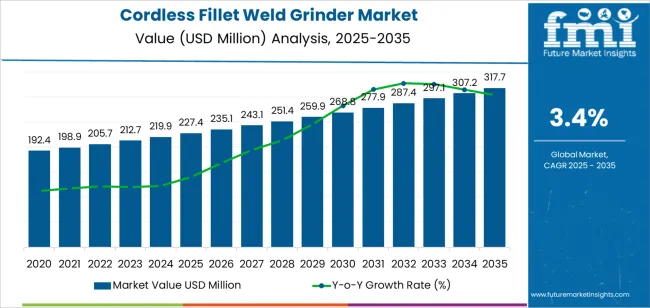
The market encompasses various power configurations, disc sizes, and specialized designs tailored for specific weld finishing applications. Modern cordless fillet weld grinders incorporate advanced brushless motor technology, integrated battery indicators, and enhanced ergonomic designs that can operate efficiently across variable load conditions while maintaining consistent performance over extended operational periods. The integration of variable speed controls, tool-free accessory changes, and enhanced safety features has further strengthened the value proposition of these grinding systems among welders seeking operational efficiency and finishing precision.
Market dynamics are significantly influenced by stringent quality control requirements, particularly in structural welding applications, pipeline construction, and heavy fabrication where weld finishing quality and operational flexibility are paramount. The construction sector's increasing emphasis on modular fabrication, field installation procedures, and quality assurance has created substantial demand for high-performance portable grinding solutions in shipbuilding operations, structural steel work, and specialized metalworking facilities. Additionally, the growing trend toward automated welding processes and quality control implementation has amplified the need for intelligent grinding systems capable of delivering consistent finishing results across diverse welding configurations.
Consumer purchasing patterns show a marked preference for modular tool systems that combine cordless operation capabilities with versatile disc options, multiple power configurations, and comprehensive battery management features for diverse metalworking applications. The market has witnessed significant technological advancement in motor efficiency design, battery technology development, and ergonomic interface systems, making these devices more suitable for demanding operational environments, extended duty cycles, and precision-critical applications.
Between 2025 and 2030, the cordless fillet weld grinder market is projected to expand from USD 227.4 million to USD 259.9 million, resulting in a value increase of USD 32.5 million, which represents 36% of the total forecast growth for the decade. This phase of development will be shaped by increasing cordless tool adoption, rising demand for portable grinding solutions, and growing availability of advanced battery management systems across manufacturing facilities and construction applications.
Between 2030 and 2035, the market is forecast to grow from USD 259.9 million to USD 317.6 million, adding another USD 57.7 million, which constitutes 64% of the overall ten-year expansion. This period is expected to be characterized by the advancement of smart battery monitoring systems, the development of energy-optimized brushless motors for extended operation, and the expansion of integrated grinding networks across diverse manufacturing and construction applications. The growing emphasis on operational efficiency and tool connectivity will drive demand for advanced cordless grinder varieties with enhanced diagnostic capabilities, improved battery performance characteristics, and superior wireless monitoring performance profiles.
Between 2020 and 2024, the cordless fillet weld grinder market experienced steady growth, driven by increasing portable tool requirements and growing recognition of cordless technology's superior performance in mobile applications following extensive industry adoption campaigns. The market developed as metalworkers recognized the advantages of cordless fillet weld grinders over corded alternatives in field applications and began seeking specialized solutions designed for precision finishing requirements. Technological advancement in battery chemistry and motor efficiency began emphasizing the critical importance of maintaining operational reliability while enhancing portability performance and improving service life across diverse grinding applications.
| Metric | Value |
|---|---|
| Estimated Value in (2025E) | USD 227.4 million |
| Forecast Value in (2035F) | USD 317.6 million |
| Forecast CAGR (2025 to 2035) | 3.4% |
From 2030 to 2035, the market is forecast to grow from USD 259.9 million to USD 317.6 million, adding another USD 57.7 million, which constitutes 64% of the overall ten-year expansion. This period is expected to be characterized by the advancement of artificial intelligence integration in tool monitoring systems, the integration of predictive maintenance analytics for optimal battery management, and the development of specialized grinder configurations for high-precision welding applications. The growing emphasis on operational efficiency and equipment connectivity will drive demand for premium varieties with enhanced cordless performance capabilities, improved battery options, and superior automated control characteristics.
Between 2020 and 2024, the cordless fillet weld grinder market experienced robust growth, driven by increasing awareness of mobility-related operational advantages and growing recognition of specialized grinding systems' effectiveness in supporting efficient metalworking operations across manufacturing facilities and construction applications. The market developed as users recognized the potential for cordless fillet weld grinders to deliver operational advantages while meeting modern requirements for precision finishing and reliable portable performance. Technological advancement in motor control optimization and battery technology development began emphasizing the critical importance of maintaining finishing quality while extending operational life and improving user satisfaction across diverse grinding applications.
Market expansion is being supported by the increasing global emphasis on operational mobility and the corresponding shift toward high-performance grinding systems that can provide superior cordless operation characteristics while meeting user requirements for precision tool operation and cost-effective portable solutions. Modern metalworkers are increasingly focused on incorporating grinding systems that can enhance operational flexibility while satisfying demands for consistent, precisely controlled surface finishing and optimized mobility practices. Cordless fillet weld grinders' proven ability to deliver portable excellence, operational efficiency benefits, and diverse application possibilities makes them essential components for mobility-focused facilities and quality-focused metalworking professionals.
The growing emphasis on modular fabrication and field installation optimization is driving demand for high-performance cordless grinding systems that can support distinctive operational outcomes and comprehensive mobility management across welding applications, construction installations, and premium metalworking systems. User preference for grinding solutions that combine functional excellence with operational freedom is creating opportunities for innovative implementations in both traditional and emerging portable tool applications. The rising influence of smart tool technologies and advanced monitoring systems is also contributing to increased adoption of intelligent cordless grinding solutions that can provide authentic operational benefits and reliable performance monitoring characteristics.
The market is segmented by power rating, application, disc size, distribution channel, and region. By power rating, the market is divided into 800W, 950W, and other power configurations. Based on application, the market is categorized into manufacturing, construction, automotive, and others. By disc size, the market includes small disc, medium disc, and large disc categories. By distribution channel, the market encompasses online sales and offline sales configurations. Regionally, the market is divided into North America, Europe, Asia Pacific, Latin America, Middle East & Africa, and other regions.
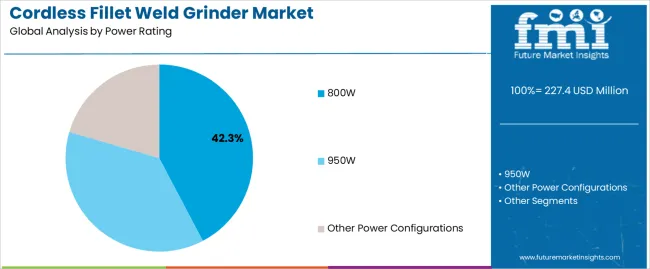
The 800W segment is projected to account for 42.3% of the cordless fillet weld grinder market in 2025, reaffirming its position as the leading power category. Metalworkers and fabrication professionals increasingly utilize 800W systems for their superior balance characteristics, established performance standards, and essential functionality in diverse grinding control applications across multiple industrial sectors. 800W grinders' proven performance characteristics and established cost-effectiveness directly address user requirements for reliable grinding control and optimal operational precision in manufacturing and construction applications.
This power segment forms the foundation of modern efficient grinding performance patterns, as it represents the power configuration with the greatest application versatility and established compatibility across multiple metalworking systems. Industrial investments in advanced cordless technology and operational optimization continue to strengthen adoption among efficiency-focused users. With metalworkers prioritizing performance balance and operational reliability, 800W systems align with both efficiency objectives and power requirements, making them the central component of comprehensive grinding control strategies.
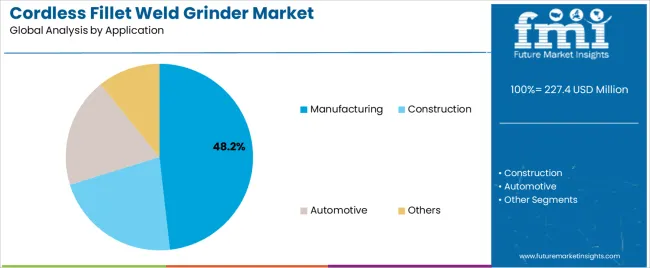
Manufacturing is projected to represent 48.2% of the cordless fillet weld grinder market in 2025, underscoring its critical role as the primary application for precision-focused users seeking superior grinding control benefits and enhanced production system management credentials. Manufacturing users and facility operators prefer manufacturing applications for their established operational requirements, proven quality demand, and ability to maintain exceptional finishing precision while supporting versatile production coverage during diverse fabrication activities. Positioned as essential applications for efficiency-focused facility managers, manufacturing offerings provide both operational excellence and quality optimization advantages.
The segment is supported by continuous improvement in automated welding technology and the widespread availability of established manufacturing standards that enable performance assurance and premium positioning at the facility level. Additionally, manufacturing users are optimizing tool selections to support production-specific applications and comprehensive quality assurance strategies. As automated welding technology continues to advance and facilities seek efficient finishing methods, manufacturing applications will continue to drive market growth while supporting operational efficiency and quality optimization strategies.
The cordless fillet weld grinder market is advancing rapidly due to increasing portable tool adoption and growing need for mobile grinding solutions that emphasize superior cordless performance across manufacturing segments and construction applications. The market faces challenges, including competition from corded tool technologies, battery life considerations, and initial investment cost factors affecting adoption rates. Innovation in battery technology enhancement and advanced motor control systems continues to influence market development and expansion patterns.
The growing adoption of cordless fillet weld grinders with tool monitoring connectivity and smart facility integration is enabling users to develop grinding strategies that provide distinctive performance benefits while commanding automated operation and enhanced real-time battery analysis characteristics. Smart tool applications provide superior operational consistency while allowing more sophisticated performance optimization features across various industrial categories. Users are increasingly recognizing the operational advantages of intelligent grinder positioning for comprehensive tool management outcomes and technology-integrated facility management.
Modern cordless fillet weld grinder manufacturers are incorporating advanced battery sensors, real-time performance monitoring capabilities, and usage analytics systems to enhance operational precision, improve equipment efficiency effectiveness, and meet industrial demands for intelligent grinding solutions. These systems improve operational effectiveness while enabling new applications, including continuous battery monitoring programs and automated optimization protocols. Advanced analytics integration also allows users to support proactive performance positioning and efficiency assurance beyond traditional grinding operation requirements.
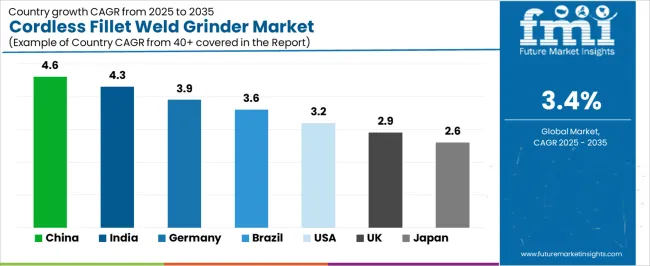
| Country | CAGR (2025-2035) |
|---|---|
| China | 4.6% |
| India | 4.3% |
| Germany | 3.9% |
| Brazil | 3.6% |
| USA | 3.2% |
| UK | 2.9% |
| Japan | 2.6% |
The cordless fillet weld grinder market is experiencing robust growth globally, with China leading at a 4.6% CAGR through 2035, driven by the expanding manufacturing sector, growing industrial automation requirements, and increasing adoption of advanced portable tool systems. India follows at 4.3%, supported by rising industrialization, expanding metalworking industry, and growing acceptance of cordless tool technologies. Germany shows growth at 3.9%, emphasizing established engineering standards and comprehensive manufacturing development. Brazil records 3.6%, focusing on industrial modernization and tool technology growth. USA demonstrates 3.2% growth, prioritizing advanced manufacturing technologies and operational optimization.
The report covers an in-depth analysis of 40+ countries, the top-performing countries are highlighted below.
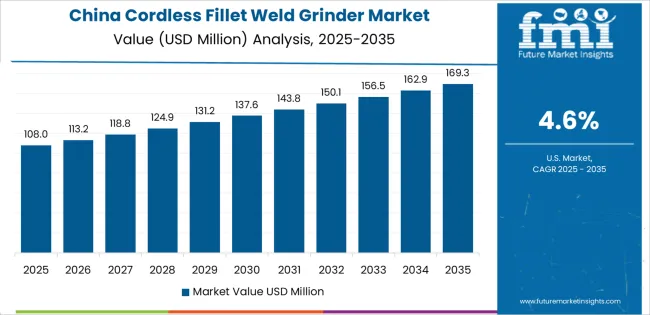
Revenue from cordless fillet weld grinder consumption and sales in China is projected to exhibit exceptional growth with a CAGR of 4.6% through 2035, driven by the country's rapidly expanding manufacturing sector, favorable government policies toward industrial modernization, and initiatives promoting portable tool technologies across major industrial regions. China's position as a global manufacturing hub and increasing focus on operational efficiency systems are creating substantial demand for high-quality cordless fillet weld grinders in both domestic and export markets. Major tool manufacturers and industrial distributors are establishing comprehensive grinding capabilities to serve growing demand and emerging automation opportunities.
Revenue from cordless fillet weld grinder products in India is expanding at a CAGR of 4.3%, supported by rising industrialization investment, growing efficiency consciousness, and expanding equipment distributor capabilities. The country's developing industrial infrastructure and increasing investment in manufacturing technologies are driving demand for cordless grinders across both traditional and modern industrial applications. International tool companies and domestic distributors are establishing comprehensive operational networks to address growing market demand for portable grinding devices and efficient automation solutions.
Revenue from cordless fillet weld grinder products in Germany is projected to grow at a CAGR of 3.9% through 2035, supported by the country's mature engineering standards, established industrial automation regulations, and leadership in precision tool technology. Germany's sophisticated manufacturing standards and strong support for advanced portable systems are creating steady demand for both traditional and innovative cordless grinder varieties. Leading tool manufacturers and specialty distributors are establishing comprehensive operational strategies to serve both domestic markets and growing export opportunities.
Revenue from cordless fillet weld grinder products in Brazil is projected to grow at a CAGR of 3.6% through 2035, driven by the country's emphasis on industrial development, manufacturing modernization growth, and growing automation distributor capabilities. Brazilian industrial users and manufacturing facilities consistently seek efficiency-focused equipment that enhances operational performance and supports modernization excellence for both traditional and modern industrial applications. The country's position as a Latin American manufacturing leader continues to drive innovation in specialized grinding applications and industrial automation standards.
Revenue from cordless fillet weld grinder products in USA is projected to grow at a CAGR of 3.2% through 2035, supported by the country's emphasis on manufacturing technology advancement, operational efficiency optimization, and advanced portable system integration requiring efficient grinding solutions. American industrial users and automation-focused facilities prioritize performance reliability and operational precision, making specialized cordless fillet weld grinders essential components for both traditional and modern manufacturing applications. The country's comprehensive industrial technology leadership and advancing efficiency patterns support continued market expansion.
Revenue from cordless fillet weld grinder products in UK is projected to grow at a CAGR of 2.9% through 2035, supported by established manufacturing standards, mature automation markets, and emphasis on operational efficiency across industrial and construction sectors. British industrial users and automation professionals prioritize quality performance and operational consistency, creating steady demand for premium grinding solutions. The country's comprehensive market maturity and established manufacturing practices support continued development in specialized applications.
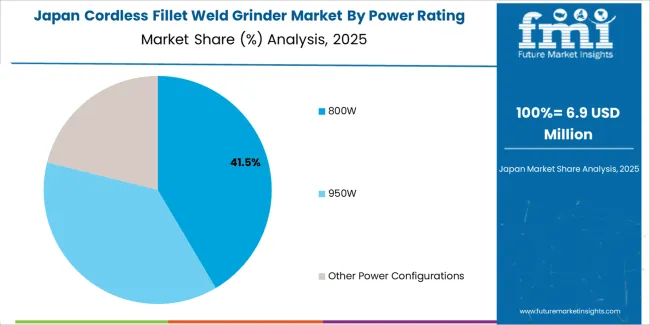
Revenue from cordless fillet weld grinder products in Japan is projected to grow at a CAGR of 2.6% through 2035, supported by the country's emphasis on precision engineering, operational excellence, and advanced technology integration requiring efficient grinding solutions. Japanese industrial users and automation-focused facilities prioritize technical performance and engineering precision, making specialized cordless fillet weld grinders essential components for both traditional and modern manufacturing applications. The country's comprehensive engineering leadership and advancing precision patterns support continued market expansion.
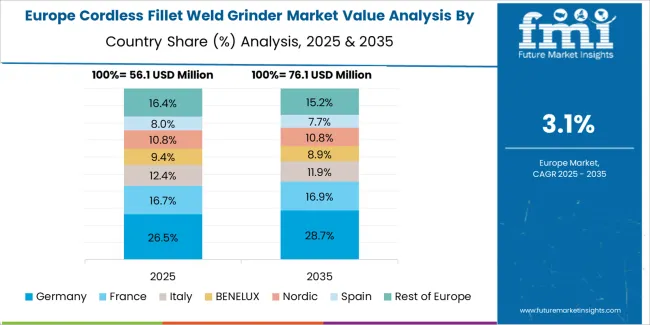
The Europe cordless fillet weld grinder market is projected to grow from USD 67.8 million in 2025 to USD 92.4 million by 2035, recording a CAGR of 3.1% over the forecast period. Germany leads the region with a 44.2% share in 2025, moderating slightly to 43.7% by 2035, supported by its strong engineering traditions and demand for premium, precision-manufactured grinding solutions. The United Kingdom follows with 19.6% in 2025, easing to 19.2% by 2035, driven by a mature industrial automation market and emphasis on operational efficiency and quality performance. France accounts for 14.1% in 2025, rising to 14.5% by 2035, reflecting steady adoption of portable tool technologies and operational optimization. Italy holds 9.8% in 2025, expanding to 10.3% by 2035 as manufacturing modernization and specialty automation applications grow. Spain contributes 6.2% in 2025, growing to 6.5% by 2035, supported by expanding industrial development and efficiency awareness modernization. The Nordic countries rise from 3.9% in 2025 to 4.1% by 2035 on the back of strong technology consciousness and advanced manufacturing methodologies. BENELUX remains at 2.2% share across both 2025 and 2035, reflecting mature, efficiency-focused industrial markets.

The cordless fillet weld grinder market is characterized by competition among established power tool manufacturers, specialized grinding equipment companies, and integrated metalworking solution providers. Companies are investing in advanced battery technologies, specialized motor engineering, product innovation capabilities, and comprehensive distribution networks to deliver consistent, high-quality, and reliable cordless grinding systems. Innovation in motor efficiency optimization, battery technology advancement, and ergonomic-focused product development is central to strengthening market position and customer satisfaction.
Metabo leads the market with 19.4% share with a strong focus on power tool innovation and comprehensive portable solutions, offering industrial and construction systems with emphasis on performance excellence and engineering heritage. FLEX GmbH provides integrated grinding automation with a focus on industrial market applications and precision control networks. C. & E. Fein GmbH delivers comprehensive portable technology solutions with a focus on commercial positioning and operational efficiency. Aerotech Abrasives specializes in comprehensive grinding systems with an emphasis on industrial applications. Suhner focuses on comprehensive metalworking equipment with advanced design and premium positioning capabilities.
The success of cordless fillet weld grinders in meeting manufacturing automation demands, operational efficiency requirements, and mobility integration will not only enhance industrial performance outcomes but also strengthen global metalworking technology manufacturing capabilities. It will consolidate emerging regions' positions as hubs for efficient portable tool production and align advanced economies with comprehensive automation systems. This calls for a concerted effort by all stakeholders -- governments, industry bodies, manufacturers, distributors, and investors. Each can be a crucial enabler in preparing the market for its next phase of growth.
How Governments Could Spur Local Production and Adoption?
How Industry Bodies Could Support Market Development?
How Distributors and Industrial Equipment Players Could Strengthen the Ecosystem?
How Manufacturers Could Navigate the Shift?
| Items | Values |
|---|---|
| Quantitative Units (2025) | USD 227.4 million |
| Power Rating | 800W, 950W, Other Power Configurations |
| Application | Manufacturing, Construction, Automotive, Others |
| Disc Size | Small Disc, Medium Disc, Large Disc |
| Distribution Channel | Online Sales, Offline Sales |
| Regions Covered | North America, Europe, Asia Pacific, Latin America, Middle East & Africa, Other Regions |
| Countries Covered | China, India, Germany, Brazil, United States, United Kingdom, Japan, and 40+ countries |
| Key Companies Profiled | Metabo, FLEX GmbH, C. & E. Fein GmbH, Aerotech Abrasives, Suhner, and other leading cordless fillet weld grinder companies |
| Additional Attributes | Dollar sales by power rating, application, disc size, distribution channel, and region; regional demand trends, competitive landscape, technological advancements in grinding engineering, cordless optimization initiatives, battery enhancement programs, and premium product development strategies |
The global cordless fillet weld grinder market is estimated to be valued at USD 227.4 million in 2025.
The market size for the cordless fillet weld grinder market is projected to reach USD 317.7 million by 2035.
The cordless fillet weld grinder market is expected to grow at a 3.4% CAGR between 2025 and 2035.
The key product types in cordless fillet weld grinder market are 800w, 950w and other power configurations.
In terms of application, manufacturing segment to command 48.2% share in the cordless fillet weld grinder market in 2025.






Full Research Suite comprises of:
Market outlook & trends analysis
Interviews & case studies
Strategic recommendations
Vendor profiles & capabilities analysis
5-year forecasts
8 regions and 60+ country-level data splits
Market segment data splits
12 months of continuous data updates
DELIVERED AS:
PDF EXCEL ONLINE
Cordless Pop Rivet Gun Market Size and Share Forecast Outlook 2025 to 2035
Cordless Blind Rivet Gun Market Size and Share Forecast Outlook 2025 to 2035
Cordless Wood Planer Market Size and Share Forecast Outlook 2025 to 2035
Cordless Trim Routers Market Size and Share Forecast Outlook 2025 to 2035
Cordless Sanders Market Analysis Size and Share Forecast Outlook 2025 to 2035
Cordless Multi Rotary Tools Market Size and Share Forecast Outlook 2025 to 2035
Cordless Garden Equipment Market
Heavy Cordless Tools Market Analysis Size and Share Forecast Outlook 2025 to 2035
Brushless Cordless Band Files Market Size and Share Forecast Outlook 2025 to 2035
Lightweight Handheld Cordless Vacuum Cleaner Market Size and Share Forecast Outlook 2025 to 2035
Fillet Weld Grinder Market Size and Share Forecast Outlook 2025 to 2035
Fish Filleting Machine Market Size and Share Forecast Outlook 2025 to 2035
Fishless Fillet Market Insights - Demand & Future Trends 2025 to 2035
Valve Grinder Market Size and Share Forecast Outlook 2025 to 2035
Angle Grinder Market Size and Share Forecast Outlook 2025 to 2035
Grain Mill Grinder Market Size and Share Forecast Outlook 2025 to 2035
Frozen Meat Grinder Market Size and Share Forecast Outlook 2025 to 2035
Cylindrical Grinders Market Growth - Trends & Forecast 2025 to 2035
Plastic Scrap Grinder Machine Market Analysis - Size, Share, and Forecast Outlook 2025 to 2035
Laboratory Grinders Market Size and Share Forecast Outlook 2025 to 2035

Thank you!
You will receive an email from our Business Development Manager. Please be sure to check your SPAM/JUNK folder too.
Chat With
MaRIA